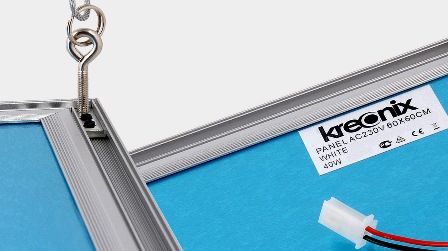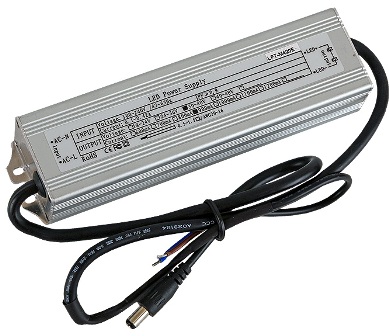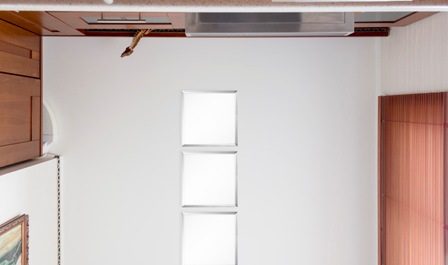Categories: Electrical Reviews, Energy saving
Number of views: 21526
Comments on the article: 4
How to save on office lighting
7 differences of a modern LED lamp
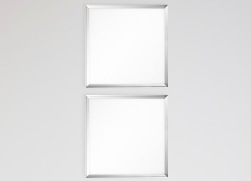 It seems that there is no such office where Armstrong-type false ceilings are not used. So tightly they entered our life. As there can be no such organization, from a kindergarten to a business center, where 60 x 60 cm ceiling lights with four fluorescent lamps, which are built into a suspended ceiling or laid on, would not be used for lighting.
It seems that there is no such office where Armstrong-type false ceilings are not used. So tightly they entered our life. As there can be no such organization, from a kindergarten to a business center, where 60 x 60 cm ceiling lights with four fluorescent lamps, which are built into a suspended ceiling or laid on, would not be used for lighting.
Such lamps have become such a familiar attribute of the modern average standard design that others are now difficult to imagine.
The power of the lamps of such lamps: 4 x 18 W or 4 x 36 W. The cost reaches 5600 rubles.
For the nineties, when incandescent lamps were widely used, the new fluorescent lamps were a real breakthrough not only in design, but also in energy saving.
However, technological progress did not stand still, and now LED lighting has become an alternative to fluorescent lamps, significantly surpassing them in energy efficiency, durability and safety.
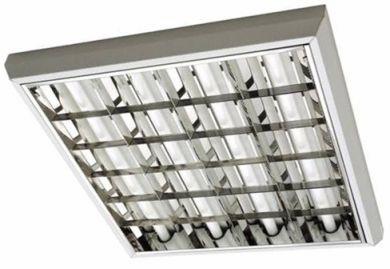
The evolution of LED light sources also touched 60 x 60 cm ceiling fixtures. The first generations of panels, studded with hundreds of planar plastic LEDs and covered with unpretentious plexiglass, are gradually replaced by more high-tech and thinner panels SMD LEDsmounted on an automated production line. A significant reduction in the use of manual labor has reduced the cost and made LED light sources available to consumers.
Such ceiling LED panels have high efficiency, and unlike luminescent ones, they consume 50% less electricity. They do not contain mercury and harmful substances, do not require maintenance during operation, and special disposal. Therefore, the use of LED light sources today is no longer a fad, but the need for real and significant energy savings, in which every zealous owner is interested.
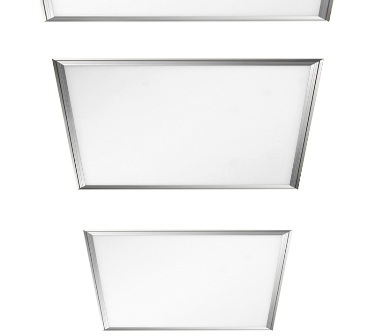
By the way, tenants are also interested in replacing ceiling lights in offices and stores with energy-efficient ones, since it is they who pay for the consumed electricity. And the costs of replacing fluorescent lamps with LEDs pay off in a year. With a large number of fixtures in the office, the cost of replacing them will pay off even earlier.
This simple, seemingly, light fixture is produced today by many Russian and foreign enterprises, but not all of them can boast of the quality and innovativeness of their products. But to understand the abundance of products on the market and competently spend money may not be easy even for techies-electricians. Not to mention the inexperienced in electrical technology owners of shops and offices.
Modern LED panels for office lighting, for example, the ultra-thin Kreonix KUP-6060-40W 60x60 cm offered by CLUSTERWIN, are only 1 cm thick! But in such lamps there are elements on the quality of which the quality of the finished product depends. The trouble is that it is often difficult to distinguish a substitution for the eye with a layman. And replacing any of the structural elements with others that are “similar in appearance” or available to manufacturers will be equivalent to replacing the engine in a Mercedes with an engine from an UAZ.
Do you think I'm talking about the case? Or for a red word? Not at all ...
I will explain with an example.
If you put nearby, for example, the Kreonix KUP-6060-40W lamp 60x60 cm and a less technological lamp from another manufacturer, which can cost more or less, the first thing that catches your eye is that the ultra-thin Kreonix shines “evenly”, with evenly brightness distributed over the area of the panel.And the “other”, simpler (but not cheaper), is strewn with bright blinding dots under the glass, which are not very pleasant to look at.
So, as a theater begins with a hanger, so does a high-tech LED lamp begin with a diffuser. And simple plexiglass or popular polycarbonate will not work here. The uniform and bright glow of the Kreonix KUP-6060-40W panel is achieved due to the innovative light guide glass developed by Mitsubishi. Glass coated with special MicroLens technology MicroLens.
You can’t make such glass on your knee. This is the first difference between the “factory samopal” and high technology.
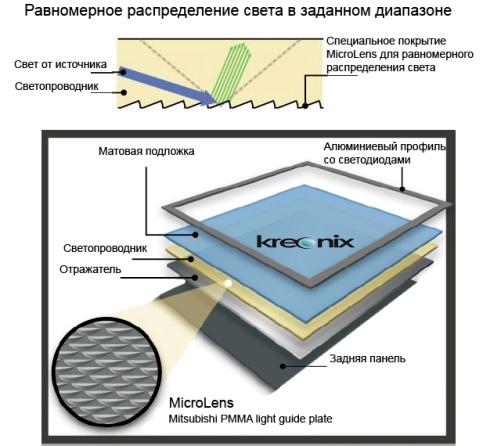
The next thing that distinguishes high technology is efficient heat dissipation. Although, this quality of LED light sources can be safely put in the first place! Too much depends on the reliability and efficiency of the heat sink!
With a small thickness of the housing, heat removal from LED crystals is a paramount and difficult task that requires accurate calculation to ensure the real life of the lamp up to 50,000 hours of continuous operation. And also - to provide a 3-year product warranty.
With a huge number of LEDs in the panel, each of which is a source of heat, a conventional printed circuit board will no longer work. Therefore, in the Kreonix KUP-6060-40W panel, the printed base is made of aluminum! And the conductive paths are isolated from the base with the thinnest oxide film! This is high technology! This is the second difference.
Mains voltage is very unstable. Even if in new areas of Moscow it is good. It's like the average temperature in a hospital! LED lights are available not only for Moscow. Therefore, the same Kreonix KUP-6060-40W should work equally reliably throughout Russia with all its “distortions and excesses” of the supply voltage.
Therefore, the third difference between a high-quality and modern LED lamp from others is an effective driver - a power supply unit for LEDs that can operate reliably at low and high supply voltage. The driver used in the KUP-6060-40W allows the luminaire to operate in the range from 100 to 240 V. What is not the third difference!
Ultra-thin Kreonix KUP-6060-40W panel can work with a dimmer! To do this, instead of the standard driver, you must connect a special controller, which is sold separately.
Why is this needed? In order to expand the scope of LED-lamp. After all, adjustable brightness can be in demand in cinemas, concert halls, in educational institutions, in meeting rooms where video presentations are held, in healthcare institutions, etc.
Why adjust the brightness of the lighting in the clinic? Yes, at least in the X-ray room, at least in the ultrasound room or at the ophthalmologist. The list goes on.
In addition, the ability to adjust the brightness of the lighting provides additional energy savings if you use automation that takes into account the actual lighting in the office or in the store. If it is sunny outside, then the brightness of the ceiling lighting is automatically dimmed to the level of the specified illumination in the room.
If outside the window is winter evening and darkness, then the LEDs take over the lighting load, working at full power. Such automation, taking into account the temperature in the street, has long been used in heating boilers, although it is not yet widespread in office lighting systems. One reason is outdated fixtures.
Perhaps the ability to adjust the brightness of lighting, this is the fourth difference between a modern LED lamp.
Enough of the differences? Or need more?
Strong, but lightweight and beautiful aluminum alloy case that fits into any design. Fifth difference.
Universal mounting and a set of mounting elements for different ceilings. The sixth difference ...
“And finally, a car!” As Yakubovich from “Field of Miracles” likes to say. Those. - price. How much should such a "miracle" cost?
And here we are faced with a peculiar paradox.It turns out that a modern innovative lamp, for example, Kreonix KUP-6060-40W, can cost no more than the old-generation lamps, but released and pushed to the market by all means, up to the administrative resource.
Let this be the seventh difference.
According to the reviews of store directors and management companies that replaced the old fixtures with Kreonix KUP-6060-40W, they cost them cheaper than those on the market. We mean quality products. Company managers and tenants need to consider the fact that when replacing dozens or hundreds of fixtures, the selling price for them will not be retail, but small-wholesale or wholesale. And this is an additional savings.
In addition, you can choose not an ultra-thin panel, but a simple LED lamp.
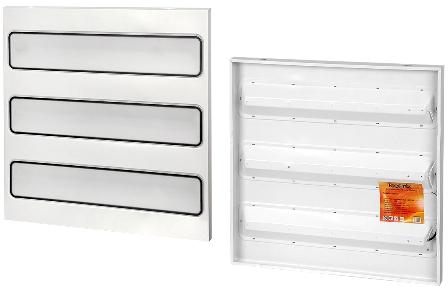
For example, the cost of a three-section LED lamp Kreonix KTP-6060 for office lighting mounted on an Armstrong ceiling is not more than 1890 rubles. In terms of illumination, it replaces a 4 * 18 fluorescent lamp one to one, but it only consumes 26 watts!
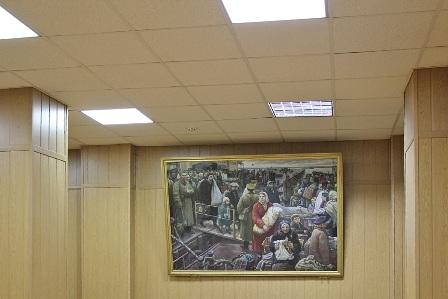
This photo shows the LED panels 60 x 60 cm in the office of a large company. The one on the right of the picture is set for comparison. This is not an LED ultra-thin panel, but an ordinary lamp in which fluorescent lamps are replaced by Kreonix 4x T8-ECO SMD 9W LED lamps with a T8 base. Its consumption is 75% lower than that of a fluorescent lamp.
Now we turn to the most important thing - we will estimate the saving of electricity and money. Really and without fools!
60 x 60 fluorescent lamp
One fluorescent lamp consumes 4x 36 W = 144 W = 0.144 kW / h
8 hours working day + 1 hour before and 1 hour after opening = 10 hours a day
One lamp consumes per day: 0.144 kW / h x 10 = 1.44 kW / h per day (for 10 hours)
One lamp consumes per month: 1.44 x 30 days = 43.2 kW / h
One lamp consumes per year: 43.2 kW / h x 12 = 518.4 kW / h
The cost of electricity per 1 lamp per year: 518.4 kW / h x 3 * rubles. = 1,555.2 rubles.
* - indicative value. In different regions it is different.
LED lamp 60 x 60
One LED panel consumes 40 W = 0.04 kW
Per day: 0.04 kW x 10 h = 0.4 kW / h
Per month: 0.4 kW x 30 days = 12 kW / h
Per year: 12 kW x 12 months = 144 kW / h
The cost of electricity per 1 lamp per year: 144 kW / h x 3 rubles. = 432 rub.
Money saving for 1 lamp: 1555.2 - 432 = 1 123.2 rubles.
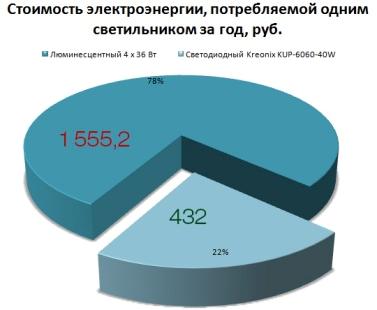
Just imagine how much money will be saved by paying lighting bills if your organization has 10 fixtures, 100 or 1000!
Yuri Shurchkov
See also at e.imadeself.com
:

